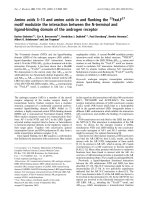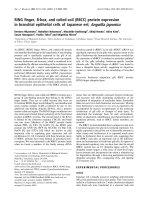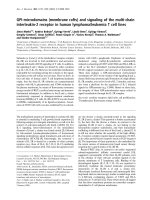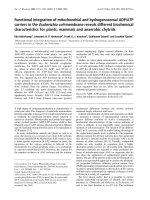Báo cáo y học: " Inhibitory short synthetic oligodeoxynucleotides and lupus" doc
Bạn đang xem bản rút gọn của tài liệu. Xem và tải ngay bản đầy đủ của tài liệu tại đây (120.2 KB, 3 trang )
Available online />Page 1 of 3
(page number not for citation purposes)
Abstract
B cells and antigen-presenting cells express a group of intracellular
Toll-like receptors (TLRs) that recognize nucleic acids and can be
accessed only when apoptotic debris or immune complexes are
internalized by B-cell receptors or Fc receptors. This results in
rapid cell activation and release of inflammatory mediators that
perpetuate the autoantibody response. TLR-7 and TLR-9 are
required to generate autoantibodies to RNA and DNA, respec-
tively. Synthetic oligodeoxynucleotides that inhibit the activity of
these intracellular TLRs attenuate systemic lupus erythematosus in
mouse models and may be of therapeutic benefit in human
systemic lupus erythematosus.
Although clonal expansion of autoreactive B and T lympho-
cytes is a hallmark of autoimmune disease, innate immunity
also plays an important role in the initiation and perpetuation
of autoimmunity. Toll-like receptors (TLRs) are innate immune
receptors that recognize structural components of micro-
organisms and trigger an immediate pro-inflammatory
response. A group of intracellular TLRs specifically recog-
nizes nucleic acids including double-stranded RNA (TLR-3),
single-stranded RNA (TLR-7/8), and CpG-rich DNA (TLR-9)
[1] (for review [2]). Once engaged, these TLRs act rapidly via
adaptor proteins to induce transcription factors for type I IFNs
and other pro-inflammatory mediators.
Access to intracellular TLRs requires that nucleic acid
antigens reach the right subcellular compartment. Immune
complexes containing nucleic acids or opsonized apoptotic
debris are internalized via Fc receptors or B-cell receptors
(BCRs) into TLR-7/9 expressing dendritic cells and B cells,
respectively [3]. Once these nucleic acid payloads enter cells
they recruit TLR-containing endosomes to form an
autophagosome, in which TLRs survey the internalized
antigen [4]. TLR engagement in plasmacytoid dendritic cells
induces type I IFN production [3], whereas TLR engagement
in B cells increases BCR signaling and antibody production
[4]. The interaction of TLRs, type I IFNs, and B-cell activating
factor (BAFF) creates an amplification loop that may
propagate the production of autoantibodies to nucleic acids
in the absence of T-cell help (Figure 1).
Studies in knock-out animals have conclusively shown that
the anti-RNA response requires TLR-7 whereas the anti-DNA
response requires TLR-9, and that both responses require
the key adaptor molecule MyD88 [5]. The importance of
nucleic acid recognizing TLRs in the pathogenesis of sys-
temic lupus erythematosus (SLE) has been further illustrated
by studies showing that TLR-7 over-expression accelerates or
initiates SLE in mice [6], whereas TLR-7 deficiency
attenuates disease [5]. Although TLR-9 deficiency abrogates
the anti-DNA response, it worsens the disease in some
strains of mice [5,7]. This may be because TLR-9 negatively
regulates the production of IFN-α in immature dendritic cells
and the increased IFN-α drives the amplification loop shown
in Figure 1; via TLR-7 upregulation, this results in selection of
B cells that secrete pathogenic anti-RNA antibodies.
Because expression of type I IFNs and BAFF is increased in
SLE patients, intracellular TLRs, type I IFNs, and BAFF/APRIL
(a proliferation ligand) are being intensely pursued as
therapeutic targets in SLE. Targeting of intracellular TLRs
was made possible by the discovery that short synthetic
oligodeoxynucleotides (ODNs) on a nuclease-resistant phos-
phorothioate backbone can either stimulate or inhibit TLR
activity. Inhibitory sequences for TLR-9 need GGG or
GGGG sequences and most also contain CCT at the 5’ end
[8]. Inhibition of TLR-7 requires a phosphorothioate back-
bone but is much less dependent on the ODN sequence.
Editorial
Inhibitory short synthetic oligodeoxynucleotides and lupus
Zheng Liu
1
and Anne Davidson
2
1
Department of Microbiology, Columbia University, New York, NY 10032
2
Center for Autoimmunity and Musculoskeletal Diseases, Feinstein Institute for Medical Research, Manhasset, NY 11030, USA
Corresponding author: Anne Davidson,
Published: 26 June 2009 Arthritis Research & Therapy 2009, 11:116 (doi:10.1186/ar2726)
This article is online at />© 2009 BioMed Central Ltd
See related research by Lenert et al., />BAFF = B-cell activating factor; BCR = B-cell receptor; IFN = interferon; ODN = short synthetic oligodeoxynucleotide; SLE = systemic lupus ery-
thematosus; TLR = Toll-like receptor.
Arthritis Research & Therapy Vol 11 No 3 Liu and Davidson
Page 2 of 3
(page number not for citation purposes)
Inhibitory ODNs are of two broad structural types. Linear
(class B) ODNs inhibit both naïve B cells and professional
antigen-presenting cells (including macrophages and
dendritic cells), whereas ODNs with more complex
secondary structure (class R) inhibit antigen-presenting cells
but have no effect on naïve B cells [8]. Most reported ODNs
inhibit both TLR-7 and TLR-9, but TLR-specific ODNs have
also been generated. In vitro, inhibitory ODNs specific for
TLR-7 or TLR-9 inhibit the stimulatory effects of RNA- and
DNA-containing immune complexes, respectively, and ODNs
specific for both TLRs inhibit the effects of both types of
immune complexes [8]. In vivo, however, inhibition of TLR-7
alone is sufficient to attenuate formation of both anti-RNA and
anti-DNA antibodies and to mitigate disease, especially at
early stages; in the only published comparative study [9],
inhibition of both TLR-7 and TLR-9 did not appear to have an
enhanced effect on disease over inhibition of TLR-7 alone.
Thus, for reasons of safety, blockade of TLR-9 alone is
probably not a good therapeutic strategy in SLE.
The fine structural features and therapeutic efficacy of a set
of inhibitory ODNs are the subject of a report by Lenert and
coworkers published in this issue of Arthritis Research and
Therapy [1]. Using ODNs that contain a palindrome and a
linear segment of various lengths, the authors show that
ODNs with progressively longer linear segments are
increasingly capable of inhibiting TLR-9 signaling in naïve
B cells. They also show that the inability of class R ODNs to
inhibit naïve B cells is bypassed when BCR signaling is
present; the most likely explanation for this observation is that
concomitant BCR stimulation promotes the formation of
autophagosomes and thus allows the ODNs to reach the
appropriate subcellular compartment [4]. Thus, if anti-nucleic
acid autoantibodies are present, then both linear and complex
ODNs should be able to access the TLR compartment in
naïve B cells in vivo. This is important because in models of
TLR-7 over-expression, excess TLR-7 on B cells alone is
sufficient to drive disease [10]. Surprisingly, the class R
(complex) ODN was more therapeutically efficacious than the
class B ODN in lupus-prone mice, although the latter could
target a wider range of cells in vitro. Despite the dual
specificity of the ODN for TLR-7 and TLR-9, the anti-RNA
response was inhibited much more effectively than the anti-
DNA response. Together, these findings suggest that caution
is needed when using in vitro data if the aim is to obtain a
reliable prediction of therapeutic efficacy of an ODN in vivo.
As inhibitory ODNs move toward clinical trials many ques-
tions remain. Will inhibitory ODNs be more effective, safer, or
more specific than blockade of other components of the
TLR/type I IFN/BAFF amplification loop? Will they synergize
with other antagonists of the other components of the loop
such as IFN-α or BAFF, or with antagonists of T-cell func-
tion? Mouse studies show that ODNs are most effective
when used as a preventive therapy [2]. What will be the
effect of ODN treatment if active inflammation is already
present? Does the autoantibody specificity (DNA or RNA, or
both) in individual patients matter? TLR-7 inhibitors do not
necessarily inhibit TLR-8 that is expressed predominantly in
human monocytes and myeloid dendritic cells and triggers a
nuclear factor-κB driven pro-inflammatory response [11].
Does TLR-8, which is not functional in mouse, play a role in
SLE pathogenesis in humans? Is there a way to optimize
ODN structure and sequence so as to achieve maximal
inhibition in vivo? Although some of these questions can be
answered by more experiments in mouse models, carefully
designed human clinical trials will be needed to evaluate the
true potential of inhibitory ODNs as therapies for SLE.
Competing interests
The authors declare that they have no competing interests.
Acknowledgements
We acknowledge support from the NIH to AD (R01 AR 049938).
References
1. Lenert P, Yasuda K, Busconi L, Nelson P, Fleenor C, Ratnabala-
suriar RS, Nagy PL, Ashman RL, Rifkin IR, Marshak-Rothstein A:
DNA-like class R inhibitory oligonucleotides (INH-ODN) pref-
erentially block autoantigen-induced B-cell and dendritic cell
activation in vitro and autoantibody production in lupus-prone
MRL-Fas
lpr/lpr
mice in vivo. Arthritis Res Ther 2009, 11:R79.
2. Barrat FJ, Coffman RL: Development of TLR inhibitors for the
treatment of autoimmune diseases. Immunol Rev 2008, 223:
271-283.
3. Gilliet M, Cao W, Liu YJ: Plasmacytoid dendritic cells: sensing
nucleic acids in viral infection and autoimmune diseases. Nat
Rev Immunol 2008, 8:594-606.
4. Chaturvedi A, Dorward D, Pierce SK: The B cell receptor
governs the subcellular location of Toll-like receptor 9 leading
to hyperresponses to DNA-containing antigens. Immunity
2008, 28:799-809.
5. Christensen SR, Shlomchik MJ: Regulation of lupus-related
autoantibody production and clinical disease by Toll-like
Figure 1
T-independent autoantibody production may be propagated by an
amplification loop involving TLRs, IFNα, and BAFF/APRIL. BAFF, B-cell
activating factor; BCR, B-cell receptor; DC, dendritic cell; FcR, Fc
receptor; IFN, interferon; IL, interleukin; mDC, monocyte-derived
dendritic cell; ODN, short synthetic oligodeoxynucleotide; pDC,
plasmacytoid dendritic cell; SLE, systemic lupus erythematosus; TLR,
Toll-like receptor.
receptors. Semin Immunol 2007, 19:11-23.
6. Deane JA, Pisitkun P, Barrett RS, Feigenbaum L, Town T, Ward
JM, Flavell RA, Bolland S: Control of toll-like receptor 7 expres-
sion is essential to restrict autoimmunity and dendritic cell
proliferation. Immunity 2007, 27:801-810.
7. Ehlers M, Ravetch JV: Opposing effects of Toll-like receptor
stimulation induce autoimmunity or tolerance. Trends Immunol
2007, 28:74-79.
8. Lenert PS: Targeting Toll-like receptor signaling in plasmacy-
toid dendritic cells and autoreactive B cells as a therapy for
lupus. Arthritis Res Ther 2006, 8:203.
9. Pawar RD, Ramanjaneyulu A, Kulkarni OP, Lech M, Segerer S,
Anders HJ: Inhibition of Toll-like receptor-7 (TLR-7) or TLR-7
plus TLR-9 attenuates glomerulonephritis and lung injury in
experimental lupus. J Am Soc Nephrol 2007, 18:1721-1731.
10. Fossati L, Sobel ES, Iwamoto M, Cohen PL, Eisenberg RA, Izui S:
The Yaa gene-mediated acceleration of murine lupus: Yaa- T
cells from non-autoimmune mice collaborate with Yaa+ B
cells to produce lupus autoantibodies in vivo. Eur J Immunol
1995, 25:3412-3417.
11. Iwasaki A, Medzhitov R: Toll-like receptor control of the adap-
tive immune responses. Nat Immunol 2004, 5:987-995.
Available online />Page 3 of 3
(page number not for citation purposes)









